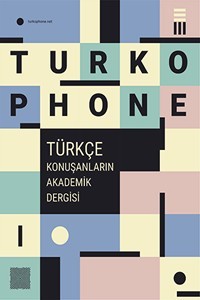Glimpses on Proverbs About Women in English And Albanian Language
Contrastive paremiology, woman, English proverbs, Albanian proverbs
Glimpses on Proverbs About Women in English And Albanian Language
Contrastive paremiology, woman, English proverbs, Albanian proverbs,
___
- Cram, D. (1983). The Linguistic Status of the Proverb. Cahiers de lexicologie,
- Grzybek, P. (1998), Sprichwort – Wahrwort? Die “Weisheit auf der Gasse” zwischen Norm und Denkmodell (2007). In Kultur und Lebenswelt als Zeichenphänomene. Jeff Bernard and Gloria Withalm (eds.) p.138. Wien: OGS/ISSS. Also in “Phraseology and culture”, edited by Paul Skandera, Mouton de Gruyter.
- Kerschen, L. (2012). American proverbs about women. Greenwood Press
- Lakoff, G, & Johnson, M. (1999). Philosophy in flesh: the embodied mind and its challenges to western thought. New York. Basic books.
- Lakoff, G. (1987). Woman, fire and dangerous things. What categories reveal about the mind. Chicago. The University of Chicago Press.
- Lakoff, G. & Johnson, M. (1980). Metaphorsweliveby. Chicago. The University of Chicago Press.
- Litovkina, A. T. (2011). Some aspects of a woman’s nature as revealed through Anglo-American anti-proverbs, in Pamies, A.; Luque Duran, JdD and Fernandez Martin, P. (eds), “Paremiologia y herencia cultural” Granada. Educatori (col Granada Lingvistica).
- Litovkina, A. T. & Mieder, W. (2006). Old proverbs never die, They just diversify: A collection of Anti-proverbs. Burlington. The University of Vermont – Veszprem. The Pannonian University of Veszprem
- Litovkina, A. T. & Mieder, W. (1999). Twisted wisdom: Modern Anti-proverbs. Burlington. The University of Vermont
- Mieder, W. (2008). Proverbs speak louder than words. Peter Lang Publishing Inc. New York
- Mieder, W. (2004). Proverbs: A Handbook. Westport. Connecticut and London. Greenwood Press .
- Mieder, W. (1999). Popular Views of the Proverb. De Proverbio, 5(2),
- Mieder, W. (1996). Prentice-Hall Encyclopedia of World Proverbs. MJF Books, 1 ed.
- Mieder, W. (1993). Proverbs are Never out of Season: Popular Wisdom in the Modern Age. Oxford. Oxford University Press.
- Mieder, W. (1989). American Proverbs: A Study of Texts and Contexts. Bern, Frankfurt/M., New York and Paris. Peter Lang.
- Profantová, Z. (1998). Proverbial tradition as cultural-historical and social phenomenon. In Europhras ’97. Phraseology and paremiology. Peter Durco ed. p.302-307. Bratislava: Akademia PZ.
- Profantová, Z. (1996). Worldview - Proverbs - narrative, in Folk Narrative and Worldview. Leander Petzoldt (eds) 2 vols. Frankfurt Am Main. Peter Lang.
- Schipper, M. (2006). Never marry a woman with big feet. Amsterdam. University Press.
- Skandera, P. (2007). Phraseology and culture. Mouton de Gruyter.
- Stefanllari, I. (2011). A course in English lexicology. Geer.
- Telija, V. N. (1998). Phraseological entities as a language of culture. p.783. In Wolfgang Eismann ed. Europhras 95.
- Thomai, J. (1999). Fjalor frazeologjik I gjuhes shqipe. Shtepia Botuese “Shkenca”.
- Thomai, J. (1981). Ceshtje te frazeologjise se gjuhes shqipe. Akademia e Shkencave e Shqiperise.
- Vyshka, G. & Cipi, B. (2010). Death rituals in Albania – An anthropological review. Antrocom Online Journal of Anthropology 2010, vol. 6, no. 2. Retrieved from http://www.antrocom.net/upload/sub/antrocom/060210/10-Antrocom.pdf.
- White, G. M. (1987). Cultural models in language and thought. D. Holland and N. Quinn, eds. Cambridge. Cambridge University Press.
- Jorgo, P. & Agron, X. (1983). Fjalë të urta të popullit shqiptar. sektori i prozes dhe i poezise popullore.
- Speake, J. (2015). Oxford Dictionary of proverbs (6 edition).
- Toena, B. (2002). Akademia e Shkencave e Shqiperise. Fjalor i shqipes së sotme.
- ISSN: 2148-6808
- Başlangıç: 2014
- Yayıncı: Bekir İNCE
Glimpses on Proverbs About Women in English And Albanian Language
Challenges of Teaching Translation of Culture-Bound Terms
Türkçenin Yabancı Dil Olarak Öğretiminde “Muhtasar Sarf Ve Lügat-ı Türki”
Yabancı Öğrencilerin Türkçe Yazma Becerisine Karşı Öz Yeterlik Algıları
The Intercultural Reflection in Lecturing German as a Foreign Language: Analysis of Textbooks
Yabancı Dil Olarak Türkçe Öğretiminde “Metin Türü Odaklı Açıklayıcı Metin Yazma Modeli”
Murat DEMİRKAN, Gülay HEPPINAR
Advertising Language Seen on The Morphological Plane
